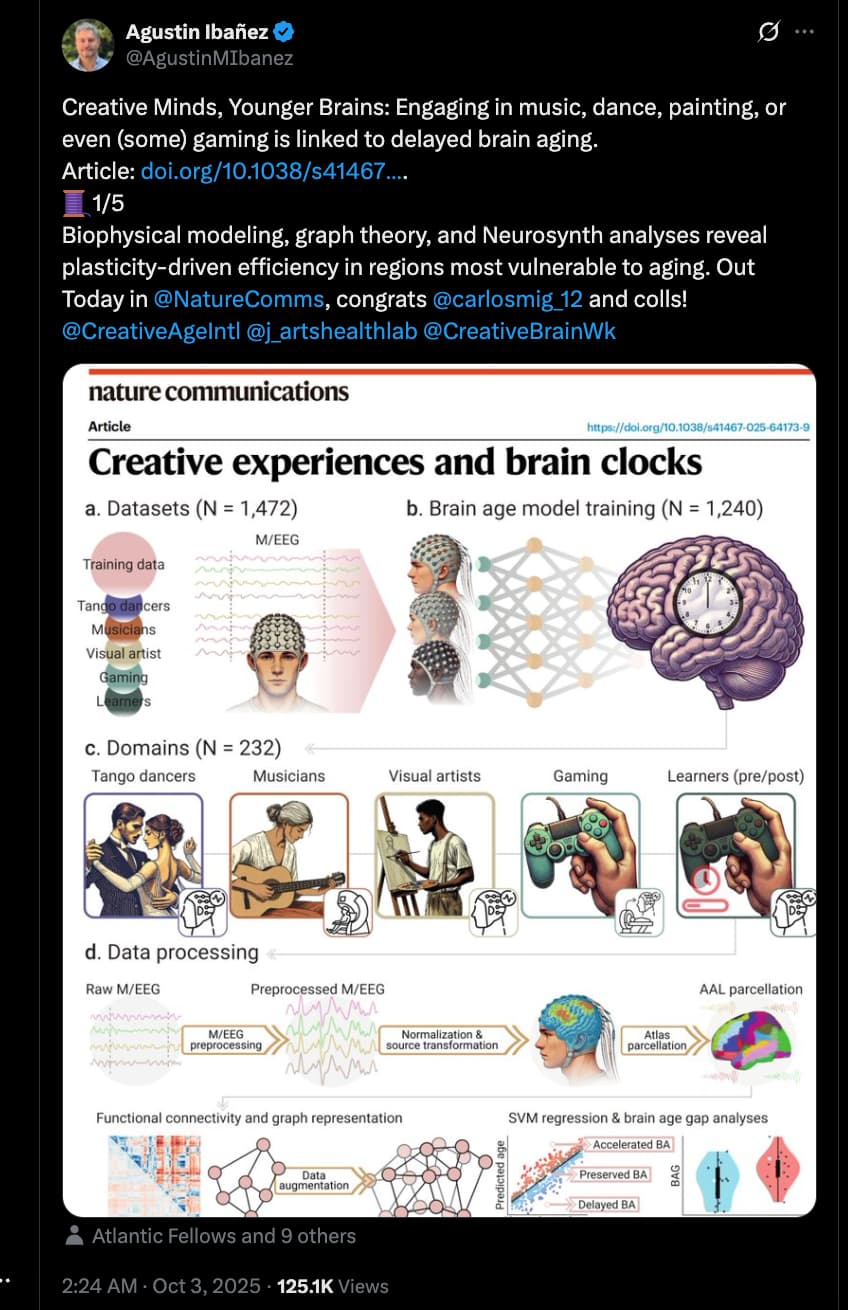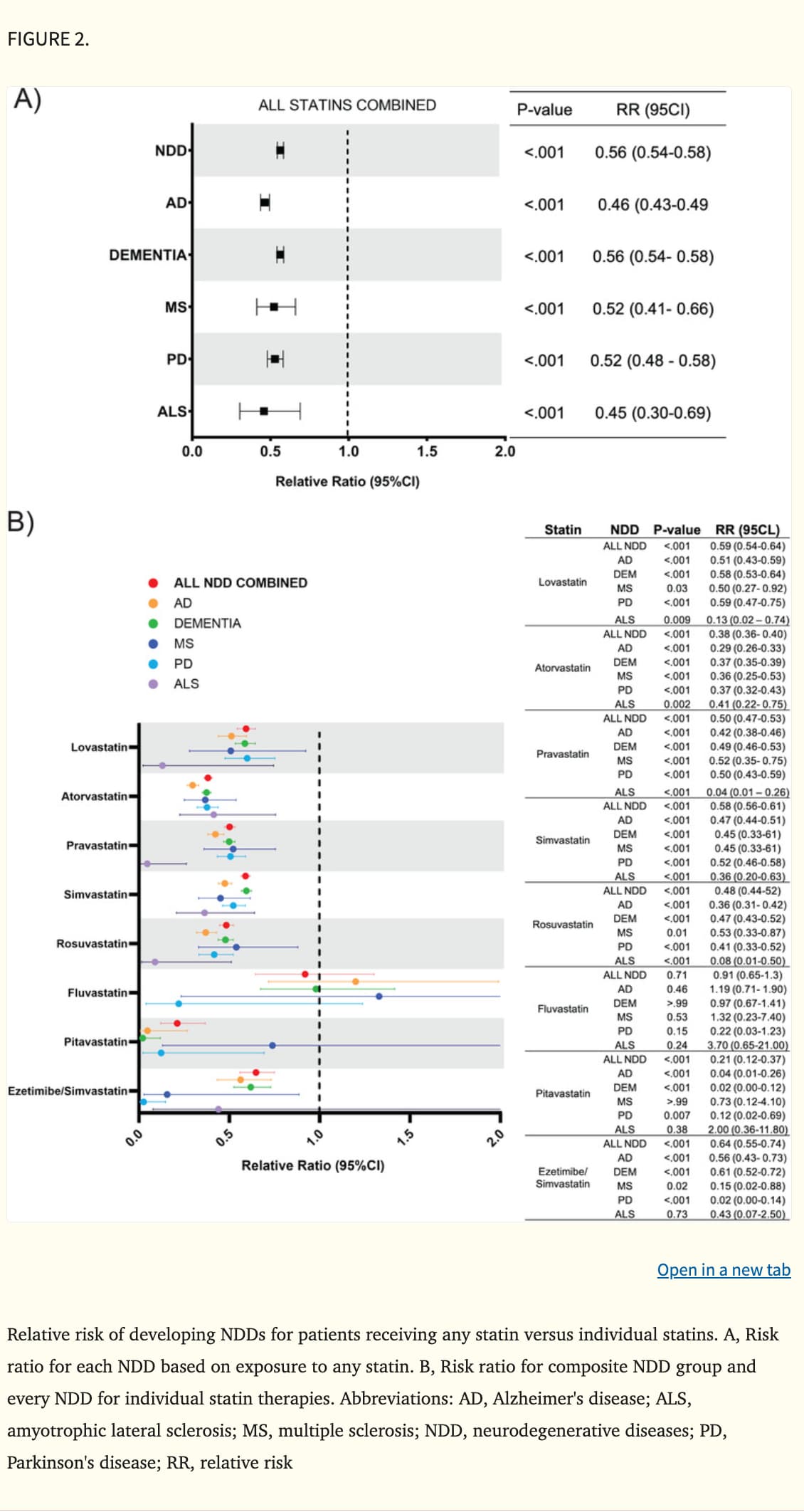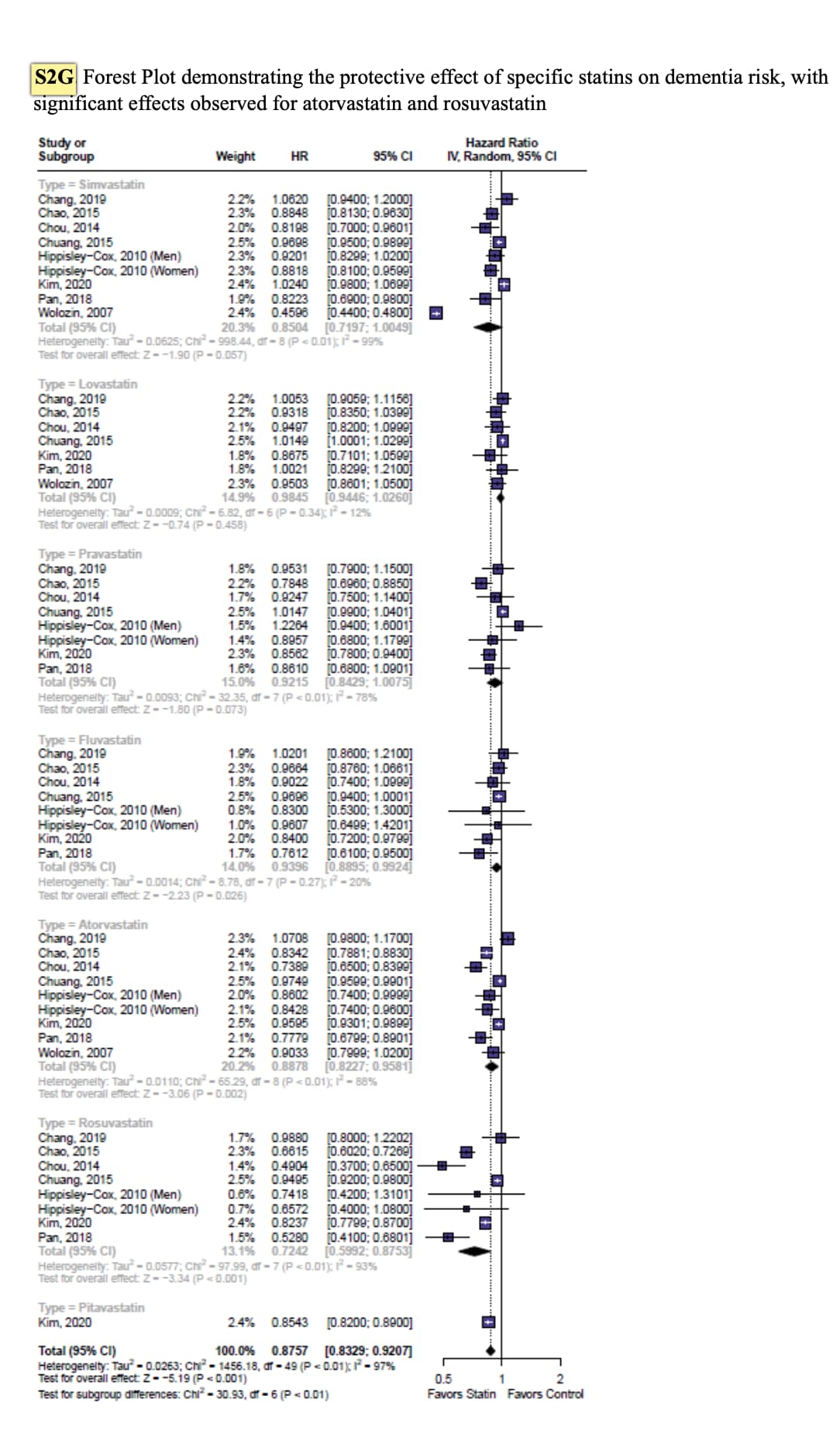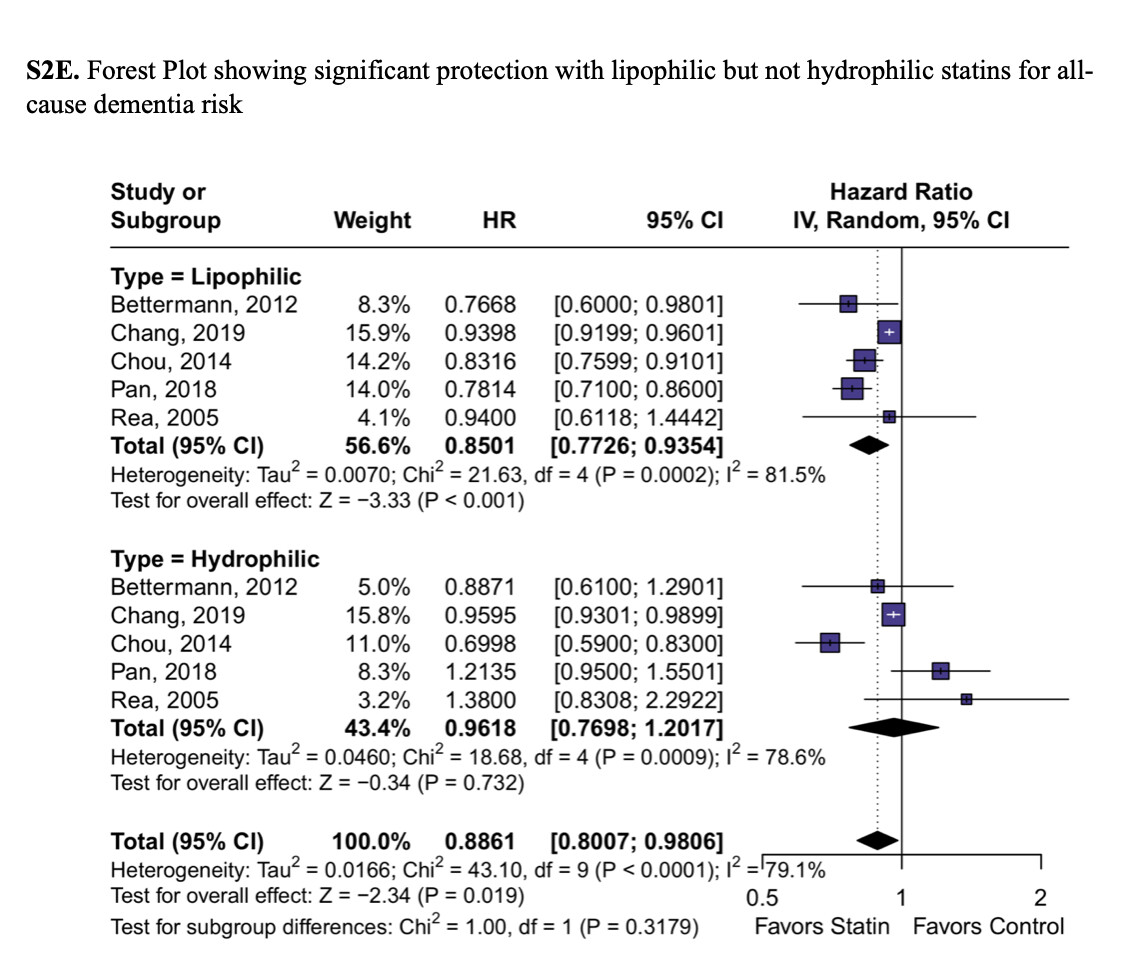Alzheimer’s gene variant in Chinese linked to rapid decline: Hong Kong study
Open access paper:
https://www.nature.com/articles/s41467-025-64173-9
Creative hobbies could slow brain ageing at the molecular level
To keep the mind young, dance the tango.
Whether it’s dancing the tango or playing the guitar, engaging in a creative pastime can slow brain ageing, according to a study of dancers, musicians, artists and video game players from multiple countries.
The analysis used brain clocks — models that measure the difference between a person’s chronological age and the age their brain appears to be — to assess whether creative activities help to maintain neurological youth. In brain regions that are most susceptible to ageing, engaging in creative activities increased connections with different areas of the brain. Although experts had ‘younger’ brains than their less-experienced counterparts did, even learning a creative skill from scratch had an anti-ageing effect on the brain.
The findings were published on 3 October in Nature Communications 1.
Read the full Nature News article: Creative hobbies could slow brain ageing at the molecular level
Her Company:
AI Summary:
Introduction to Neuroage Therapeutics
- Dr. Kristen Glorioso, a physician and neuroscientist, is the co-founder and CEO of Neuroage Therapeutics, an early-stage biotech company focused on reprogramming brain aging to treat dementia.
- The foundation of Neuroage is built upon two decades of Dr. Glorioso’s research at MIT and Carnegie Mellon, emphasizing the potential to address neurodegenerative diseases through therapeutic and lifestyle interventions.
- Neuroage offers a consumer-facing product called the Neuroage test, which assesses brain age and predicts future risks of neurodegenerative diseases over 30 years in advance.
- The test utilizes a multiomic and multimodal approach, generating a unique longitudinal dataset essential for drug discovery related to Alzheimer’s disease and mild cognitive impairment.
- Neuroage positions itself similarly to Tesla, utilizing consumer products to gather data that can inform future innovations in Alzheimer’s research.
Personal Motivation for Founding Neuroage
- Dr. Glorioso’s personal connection to Alzheimer’s disease stems from her grandmother’s seven-year battle with the condition, which significantly influenced her career path.
- The impact of her grandmother’s illness was compounded by the fact that her aunt is currently facing late-stage Alzheimer’s, further intensifying Dr. Glorioso’s commitment to finding solutions.
- Dr. Glorioso has a genetic risk factor, the ApoE4 allele, which is associated with a higher likelihood of developing Alzheimer’s, making the issue of dementia particularly personal and urgent for her.
- Globally, over 60 million people suffer from age-related neurodegenerative conditions, with aging being the most significant risk factor for dementia, particularly after age 70.
Understanding Dementia and Its Types
- Dementia is an umbrella term encompassing various types, including Alzheimer’s disease, vascular dementia, and frontotemporal dementia, all sharing common symptoms like memory loss and disorientation.
- Alzheimer’s disease is the most prevalent form of dementia, followed by vascular dementia and mixed dementia, each associated with the death of neurons in specific brain regions.
- The loss of neurons can be visualized via MRI or postmortem examinations, revealing distinct patterns of brain shrinkage based on the type of dementia.
- Different types of dementia arise from various causes, such as cardiovascular issues leading to vascular dementia or alcohol-related conditions resulting in Wernicke’s encephalopathy due to vitamin B1 deficiency.
Diagnosis and Importance of Timely Intervention
- Diagnosing dementia involves ruling out vitamin deficiencies and thyroid issues, conducting brain MRIs, and performing physical exams to assess movement disorders like tremors.
- The commonly used mental status exam consists of 30 questions designed to evaluate orientation, memory, and cognitive function, with a typical score of 30 indicating normal cognitive health.
- Timely diagnosis is crucial, as some dementia causes can be reversible, such as thyroid conditions or vitamin deficiencies that can be treated effectively.
- Understanding the underlying causes of dementia is essential for treatment, as certain conditions can be managed similarly to cardiovascular diseases, emphasizing the importance of early detection and intervention.
The Amyloid Hypothesis and Its Controversies
- The amyloid hypothesis posits that amyloid plaques in the brain are a primary cause of Alzheimer’s disease, a theory that originated from early examinations of Alzheimer’s patients’ brains.
- Recent research has raised questions about the amyloid hypothesis, particularly since many cognitively normal individuals exhibit amyloid accumulation without showing symptoms of Alzheimer’s.
- New tools, such as PET scans and blood tests, have been developed to measure amyloid levels in living patients, enabling better tracking of disease progression and risk assessment.
- Despite advancements, the amyloid hypothesis remains contentious, with some studies revealing falsified data and challenges related to mouse models that do not accurately reflect human Alzheimer’s pathology.
Recent Developments in Alzheimer’s Drug Therapies
- Two recent drugs targeting amyloid, Donanemab by Eli Lilly and Lecanemab by Biogen, have been approved, showing a 30% reduction in disease progression but with significant side effects.
- Approximately 50% of patients treated with Donanemab exhibited no progression of Alzheimer’s or mild cognitive impairment after one year, indicating potential efficacy despite the risks involved.
- The approval and use of these drugs highlight the importance of understanding amyloid as a risk factor rather than a sole cause of Alzheimer’s disease.
- Future research aims to better segment patients for treatment, as earlier intervention is crucial for the effectiveness of these therapies, which may eventually evolve into preventative measures against dementia.
Neuroage’s Innovative Approach to Brain Aging
- Neuroage is exploring a novel theory of Alzheimer’s that focuses on brain aging itself, identifying specific pathological processes that occur even in young adults.
- Key factors in brain aging include calcium dysregulation, mitochondrial dysfunction, DNA damage, and changes in neurotransmitter signaling, all of which contribute to the hallmarks of cognitive decline.
- The company has identified “boss proteins” that regulate gene expression changes leading to brain aging, which may be targetable by drugs for therapeutic interventions.
- Through machine learning algorithms, Neuroage can predict brain age based on various biological markers, allowing for the identification of individuals at risk for Alzheimer’s disease.
The Neuroage Test and Lifestyle Interventions
- The Neuroage test combines genetic data, brain MRI results, and cognitive assessments to produce a comprehensive brain aging score, which can inform lifestyle modifications to reduce dementia risk.
- Research indicates that approximately 40% of brain aging is influenced by lifestyle choices, including exercise, diet, sleep, stress management, and mental activity.
- The test provides personalized recommendations based on individual health data, encouraging users to adopt healthier habits to improve their cognitive health.
- Recent studies have shown that even small increases in physical activity can lead to measurable improvements in brain health, highlighting the importance of lifestyle interventions in dementia prevention.
Future Directions and Clinical Applications
- Neuroage aims to develop therapeutics targeting the biological mechanisms of brain aging, with a focus on small molecules and antibodies that could potentially reverse cognitive decline.
- The company is building a robust dataset from the Neuroage test, which will serve as a foundation for future drug development and clinical research.
- Neuroage’s approach emphasizes the use of multiomic data to identify genes and pathways responsible for variations in brain aging rates among individuals.
- The ultimate goal is to create a preventative framework for dementia, similar to how cholesterol levels are monitored for heart disease risk.
Conclusion and Call to Action
- Dr. Glorioso invites individuals to participate in the Neuroage test, emphasizing the importance of early detection and lifestyle management in the fight against dementia.
- The company is launching its consumer-facing product and aims to make brain health monitoring as routine as other health checks.
- Through ongoing research and collaboration, Neuroage seeks to transform the landscape of Alzheimer’s treatment and prevention, ultimately improving the quality of life for millions affected by neurodegenerative diseases.
“A version of this article was originally published in February 2025.”
Discussed there: What are your homocysteine levels? What have you done to reduce it? Why isn't it part of PhenoAge or aging.ai clocks? - #124 by adssx
An old high school friend whom I keep in touch with via email is telling me he is having trouble with short term memory and what sounds like a loss of focus. He was an avid reader but tells me now that he can’t concentrate well enough to read certain books. I would like to offer some guidance that might be helpful but it would have to be something uncomplicated. He is very much unlike our group here in that he isn’t interested a “believer” in supplements but I think he would try something uncomplicated.
I understand that the options here may be few, especially given how little we know, but I am asking for suggestions. My first thought is that deficiencies of B-12, folate, and metabolic disruptions could account for his short term memory issues and should be ruled out before moving on to suspecting AD.
How would you approach this issue with a friend who would likely not be open to a full on assessment and experimentation?
“ACD856, or ACD-856, is a tropomyosin receptor kinase TrkA, TrkB, and TrkC positive allosteric modulator which is under development for the treatment of Alzheimer’s disease, depressive disorders, sleep disorders, and traumatic brain injuries. It is taken by mouth.”
ACD856 Pubmed review.pdf (37.8 KB)
That’s a tough one especially if he isn’t open minded about supplements with scientific support. Rapa, with its regementation, blood levels, perhaps even physician oversight may be more than he is willing to try but definitely would be #1 on my list. The other “supplement” that he may be more likely to try is Lithium. It’s easily obtained over the counter or Amazon and has developing scientific evidence that it could be an important supplement for people at risk for Alzheimers and even those with mild cognitive delay. I’d start with 5 mg elemental Li in the chemical form of lithium orotate.
Also see this thread Lithium Supplementation - #319 by Agetron
Can understand.
You definitely… recommend B12 and Lithium Orotate -
Before bedtime I take:
B12 1,000 mcg daily
Lithium Orotate 10 mg
He Was Expected to Get Alzheimer’s 25 Years Ago. Why Hasn’t He?
Scientists are searching for the secret in Doug Whitney’s biology that has protected him from dementia, hoping it could lead to ways to treat or prevent Alzheimer’s for many other people.
For 14 years now, Mr. Whitney has been the one-person focus of exceptionally detailed scientific investigation, for which he travels periodically to St. Louis from his home in Port Orchard, Wash. It is not because he is ill. It is because he was supposed to be ill.
Mr. Whitney, 76, is a scientific unicorn with potential to provide answers about one of the world’s most devastating diseases. He has a rare genetic mutation that essentially guaranteed he would develop Alzheimer’s disease in his late 40s or early 50s and would likely die within a decade.
His mother and nine of her 13 siblings developed Alzheimer’s and died in the prime of their lives. So did his oldest brother, and other relatives going back generations. It is the largest family in the United States known to have an Alzheimer’s-causing mutation.
“Nobody in history had ever dodged that bullet,” Mr. Whitney said.
But somehow, he has done just that. Something has shielded him from his genetic destiny, allowing him to escape Alzheimer’s for at least 25 years longer than anyone expected.
Full story: He Was Expected to Get Alzheimer’s 25 Years Ago. Why Hasn’t He?
Rapid amyloid-β clearance and cognitive recovery through multivalent modulation of blood–brain barrier transport -Nature 2025
- They built “supramolecular” nanoparticles that mimic the ligands of the BBB receptor LRP1. After IV injection in AD mice, the particles restored BBB transport and triggered the brain’s own clearance pathway. Within ~1 hour, brain amyloid-β dropped by ~50–60%, with longer-term behavioral recovery reported in follow-ups. The key point is that the nanoparticles are bioactive (drug-like)—not mere carriers—and they re-establish BBB function, which then clears plaque. It also rapidly lowered albuminuria.
Has anyone looked closely into pitavastatin?
This study got me interested:
Key chart:
In contrast, this study found no statistically significant benefit for pitavastatin and concluded that rosuvastatin performs best. Unfortunately, it doesn’t report the odds ratio or confidence interval for pitavastatin.
"Additionally, rosuvastatin demonstrated the most pronounced protective effect for all‐cause dementia among specific statins (HR 0.72; 95% CI: 0.60 to 0.88). "
They also looked into hydrophilic vs lipophilic statins:
For AD specifically, both hydrophilic (17% reduction) and lipophilic (15% reduction) statins showed significant effects.
Research paper (open access)
https://www.tandfonline.com/doi/full/10.1080/1028415X.2025.2538062#abstract
Cholesterol-lowering drug targets reduce risk of dementia: Mendelian randomization and meta-analyses of 1 million individuals
INTRODUCTION
We tested whether genetically proxied non-high-density lipoprotein cholesterol (non-HDL-C)–lowering drug targets reduce risk of all-cause dementia.
DISCUSSION
Genetic lowering of non-HDL cholesterol via HMGCR, NPC1L1, and CETP reduces the risk of dementia. This reflects the effect of lifelong differences in non-HDL cholesterol on risk of dementia.
Highlights
- Variants in HMGCR, NPC1L1, and CETP reduce the risk of dementia via non-high-density lipoprotein cholesterol (non-HDL-C).
- An effect of PCSK9, ANGPTL4, and LPL variants on dementia risk cannot be excluded.
- This reflects the effect of lifelong lower non-HDL-C on risk of dementia.
https://alz-journals.onlinelibrary.wiley.com/doi/10.1002/alz.70638
RobTuck, He could try the following site. If he is willing to experiment with how the web page works he may find something worthwhile: Ratings | Cognitive Vitality | Alzheimer's Drug Discovery Foundation
RapAdmin, I’m going out on a limb here to give an opinion from a non-medical person about this article. My thought is that damaged capillaries in the brain lead to reduced blood flow with resulting reductions in incoming nutrients and outgoing contaminants. This results in a poorly functioning brain with a buildup of plaques.
Damaged capillaries can be caused by too much sugar (glucose) in the blood. Whether it’s just high blood sugar in general or technically classified as diabetes, controlling blood sugar levels is one of my major concerns for maintaining brain health.
I’ll leave it up to the experts to correct any of my errors.




